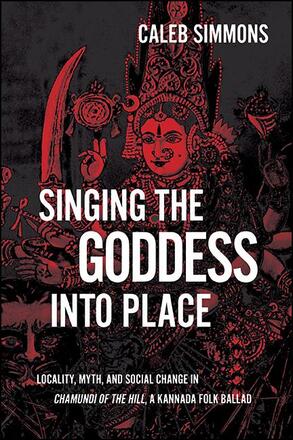
Singing the Goddess into Place
Locality, Myth, and Social Change in Chamundi of the Hill, a Kannada Folk Ballad
Alternative formats available from:
Explores how a folk ballad in southern India transforms the landscape and embeds the deities that are its subject within the social worlds of their devotees.
Description
Singing the Goddess into Place examines Chamundi of the Hill, a collection of songs that tells the stories of the gods and goddesses of the region around the city of Mysore in southern Karnataka. The ballad actively transforms the region into a land where gods and goddesses live, embedding these deities within the social worlds of their devotees and remapping southern Karnataka into sacred geography connected through networks of devotion and pilgrimage. In this in-depth study of the songs and their context, Caleb Simmons not only provides the first English-language translation of these songs but brings to light the unstudied folk perspectives on the foundational myth of Mysore and its urban history. Singing the Goddess into Place demonstrates how folk narratives reflect local context while also actively working to upend social inequities based on caste and ritual/devotional practices. By delving into this world, the book helps us understand how a landscape is transformed through people's relationship with it and how this relationship helps build meaning for the communities that call it home.
Caleb Simmons is Associate Professor of Religious Studies and Faculty Director of the Bachelor of General Studies Program in the College of Humanities at the University of Arizona. He is the author of Devotional Sovereignty: Kingship and Religion in India and coeditor (with Moumita Sen and Hillary Rodrigues) of Nine Nights of the Goddess: The Navarātri Festival in South Asia, also published by SUNY Press.
Reviews
"Simmons raises important questions about different kinds of narratives in Hindu traditions, and this book is an excellent pedagogical resource." — Reading Religion
"Caleb Simmons has written a compelling study that sheds light on a local tradition of wider importance and bears broad significance to the study of religion in South Asia, with a particular contribution to the much‐neglected subject of popular religious ballads (sometimes referred to as 'oral epics' or 'folk narratives'). The Kannada‐speaking culture is known for its originality and richness but also for being woefully understudied. This book brings to light the rich local culture of Mysore, a necessary stop on a scholar's path that few write about, and thereby fills a real gap in the study of the region by illuminating a neglected hinterland between ethnography and textual studies." — Gil Ben-Herut, author of Siva's Saints: The Origins of Devotion in Kannada according to Harihara's Ragaḷegaḷu
"The strength of the book is also the interest of the ballad under review; it shows a Mysore-centric goddess tradition in which the fortunes of the kings and their people are woven together in an elite and popular, or high and low (as the author frames the distinction), whole. The inclusion in the ballad of roads, places, social customs, clothing styles, and foods specific to Mysore situates the Goddess; she takes place, or makes her place, in Mysore. This book will be assigned in courses on Hinduism or South India, probably in religion departments and for undergraduates."— Rachel Fell McDermott, author of Revelry, Rivalry, and Longing for the Goddesses of Bengal: The Fortunes of Hindu Festivals